What are the most important trends influencing our future? In our update, we focus on five themes: the urgency of ecological reconstruction; the strengthening of relational power; the ageing and diversification of the population; technology becoming embedded in everything; and the redefinition of the economy. In addition to these five megatrends, it is important to consider the tensions between them as well as the metatrends that cut through all of the megatrends.
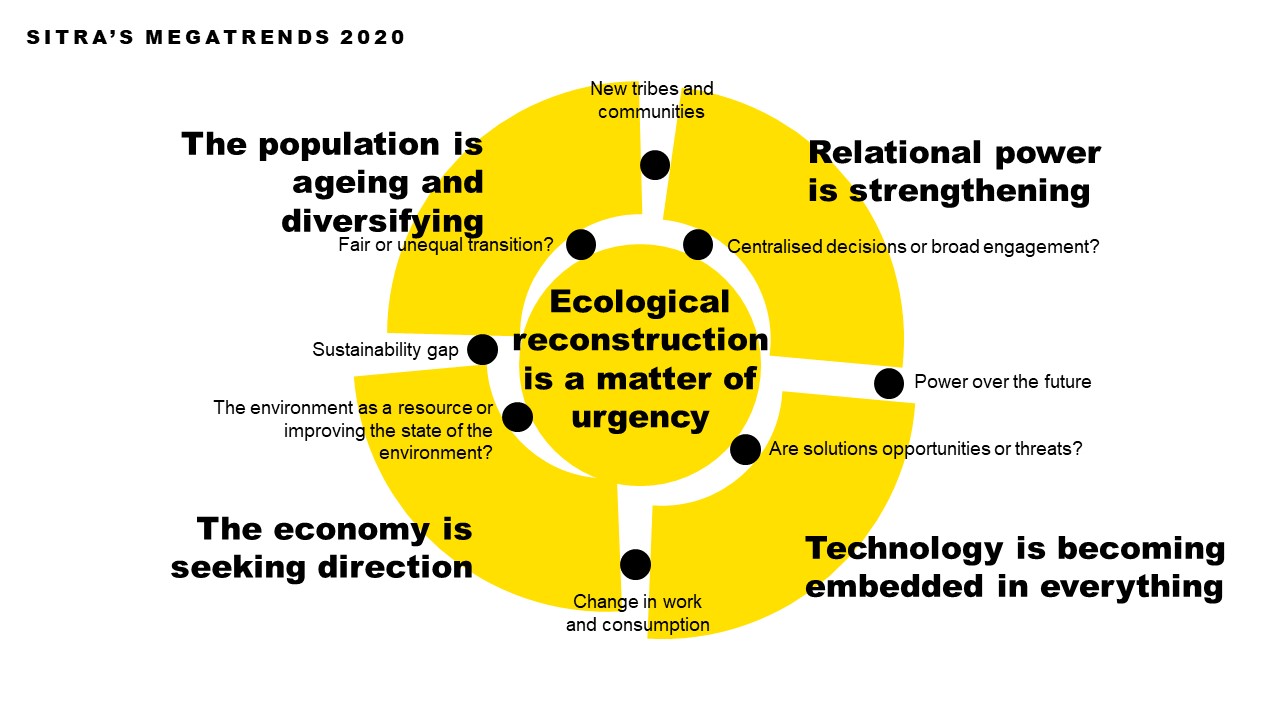
The key factor influencing the future is our response to the ecological sustainability crisis: climate change, decreasing biodiversity, the excessive consumption of resources and waste-related problems. There is a growing urgency for ecological reconstruction, which means transitioning to a society that improves the state of the environment and human well-being. The next 10 years will be crucial to our success in reconstructing society to make it sustainable and resilient while adapting to the changes brought about by climate change and decreasing biodiversity. This transformation is a matter of increasing urgency, and the tensions related to it are growing. These tensions can be analysed by examining the ecological sustainability crisis in relation to other megatrends.
The tensions between the strengthening of relational power and the urgency of ecological reconstruction is related to finding a balance between quick decisions, engagement and the strengthening of democracy. We are facing a shift from a multipolar world to a poly-nodal world where power will be determined by, among other things, the level of economic, technological and cultural interaction and the breadth of relational networks. Social systems are being put to the test as to which of them is the most effective at responding to the ecological sustainability crisis and the challenges of a complex world. Some people view democracy as being too slow and distant for deciding on things. At the global level, it is hoped that strong leaders will bring simplicity to the confusing situation but, at the same time, there are increasing efforts to influence things at the grass-roots level.
With respect to the ageing and diversification of the population, the question concerns the fairness of ecological reconstruction: how can we find the right balance between quick action and the need to reduce inequality? The population is ageing and becoming increasingly diverse with regard to people’s backgrounds, opportunities and habits. At the same time, views and opinions are becoming sharper and more confrontational, leading to a desire for constructive discussion about values. Reducing the inequality brought about by technology, geographical polarisation and changing working life while engaging in ecological reconstruction requires the continuous development of competence and new paradigms. How can we achieve a renewal of culture, the structures of society and, for example, the system of education and prevent increasing inequality?
When technology becomes embedded in everything, the tension that emerges is between seeing technology as an opportunity and deeming it a threat with regard to ecological reconstruction. The key is the role of technology and data and who decides on it. Technology continues to develop rapidly and it is becoming embedded in society and daily life. Data is increasingly accumulated and its value and significance are growing. While it presents new solutions in areas such as energy production and the more efficient use of resources, it has simultaneously led to a significant increase in the demand for energy and resources.
In the context of the redefinition of the economy, the tension is related to the objective being pursued: there is growing consensus regarding the problems of the economic system with respect to the concentration of wealth and environmental impacts, among other things. At the same time, however, the existing problematic practices and structures seem difficult to part with. Can we redefine the economy quickly enough and shift to improving the state of the environment instead of viewing the environment as a boundary condition? Will we engage wholeheartedly in ecological reconstruction or persist with our old ways of thinking?
While the ecological sustainability crisis and our response to it will play a key role in shaping our future, not all of the significant changes and tensions are directly related to it. There are countless tensions and interrelationships between the other megatrends, and we highlight four of those tensions here to stimulate the discussion about the future.
When it comes to the link between the ageing of the population and the reform of the economic system, we should consider the sustainability gap: changes in population structure – particularly ageing, lower birth rates and the resulting decrease in the size of the working-age population – will put pressure on the financial base of the welfare society. This development will be allied to the need to ensure people’s livelihood as working life becomes increasingly uncertain.
In the interrelationship between the economy and technology, the key tension involves the transformation of work and consumption: technology and new operating models – such as those related to the circular economy – will change the ways we work and the content of work while also transforming industries, putting more pressure on the economy to change. The platform economy and the sharing economy as part of the circular economy will transform not only work but also consumption.
Questions of power are highlighted when it comes to the development and adoption of technology. When we examine this with reference to relational power, the question of future power emerges: who will get to decide on technology and who will own the continuously accumulating data? There is a need to regulate rapidly developing technology and establish fair rules for the use of data, but legislation is struggling to keep up. The use of data can bring significant added value to economic competitiveness but, thus far, it has been more notably employed as a tool in the use and abuse of influence and power in the context of elections, for example. Even in a more general sense, technology is increasingly seen as a geopolitical issue of power. However, this is not only an issue of technology, but also future power in a broader sense, which refers to who defines our visions of the future and who is represented in them.
The tension between relational power and the ageing and diversification of the population is related to new tribes and communities. The desire for permanence and simplicity in a world perceived as complex can easily lead to a polarisation of discussion and extreme attitudes becoming part of one’s identity. People want prospects, security and opportunities for moving ahead in life. The absence of these can lead to frustration and withdrawal, which, in the worst case, can result in identification with extreme attitudes. The outcome of this is the creation of new communities that differ drastically from each other in terms of their values.
Merely being able to identify tensions suggests it is possible to influence the future.
Behind the megatrends, we can identify metatrends that cut through various themes and influence changes in the trends. They can help us establish a better understanding of the big picture formed by the megatrends and changes therein. One such metatrend is the transition to the post-normal age, which is characterised by surprise, discontinuity and polarisation. The strong influencing of emotions and an emphasis put on their significance are also evident. Moreover, in this era of increased interconnectedness and interdependence, loneliness and isolation are also growing, and you could say that people are alone together. The metatrends will be addressed in more detail in Chapter 8.
The overall picture of the megatrends and the tensions between them may feel exhausting, challenging and even frightening. However, merely being able to identify these tensions suggests that it is possible to influence the future. The tensions and uncertainties constitute an opening where the direction of development is more open than usual. Today’s decisions and actions will have an impact on the direction of development – will this direction be the same as before? Will development proceed in a new, previously unseen direction? Or will a state of tension remain?
We can find new ways to strengthen democracy, make decisions quickly and reform our society. At the same time, we can ensure that everyone is heard and the transition is fair. A new kind of economic system – such as one based on the circular economy – may contribute to the improvement of the state of the environment and well-being in the long term, and technology may offer solutions, provided that it is managed appropriately. There is a wide range of alternative futures available, some of which in many ways promise to make things better than at present. Our eventual future depends on our current choices and actions. The megatrends and the tensions related to them are described in more detail in the following chapters.







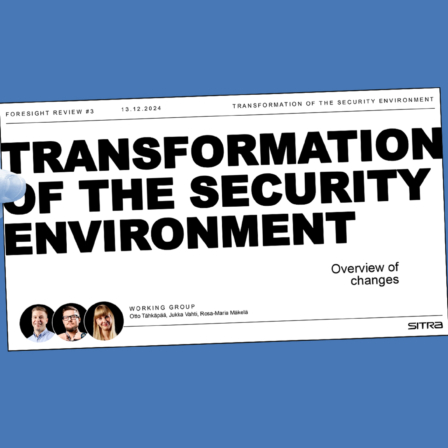

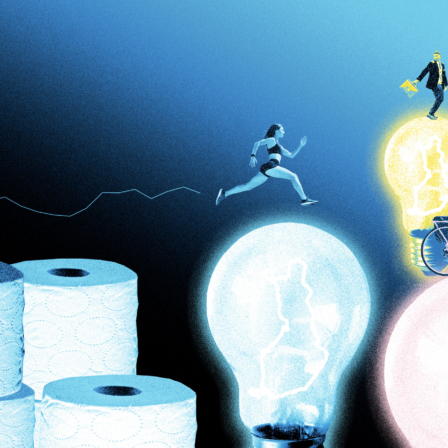

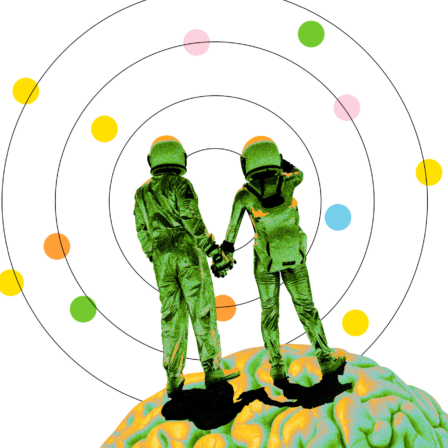



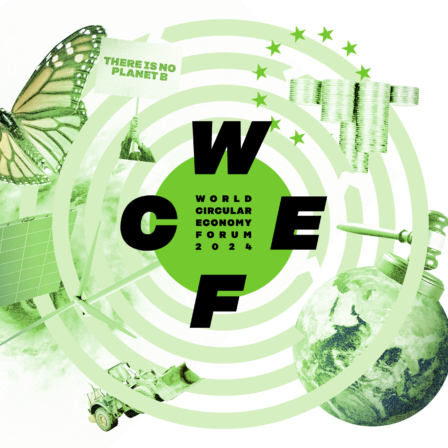
Recommended
Have some more.